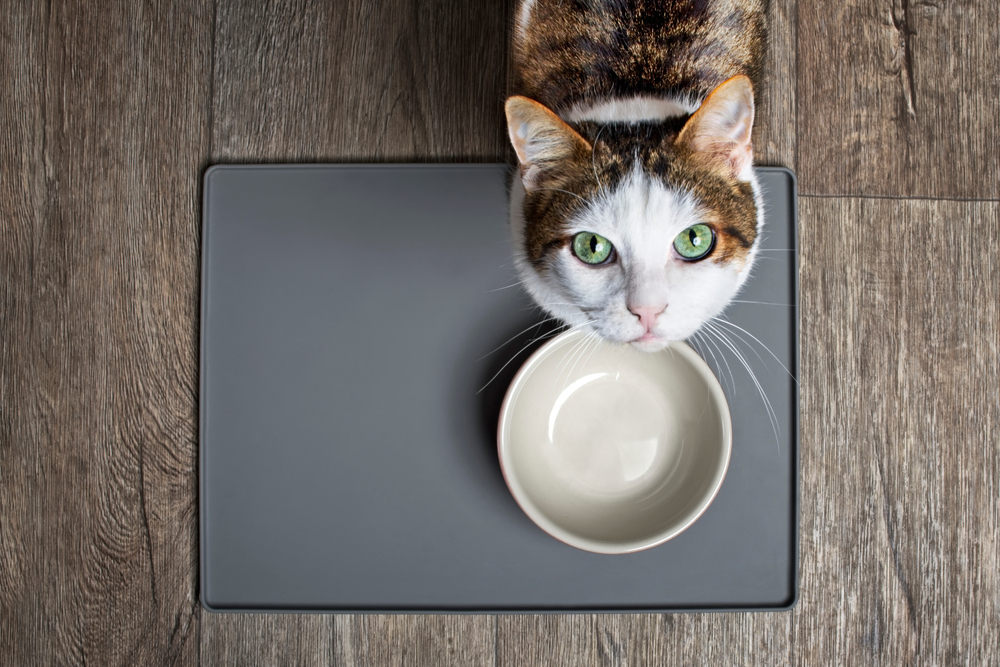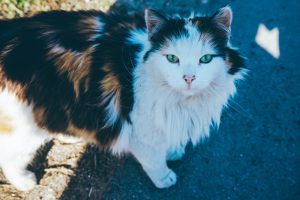When we get a new kitten or adopt an older feline friend, we take great strides to ensure that they have the things that will make them comfortable, happy, and healthy.
This may mean getting toys, a comfy bed, and a scratching post to take care of their claws.
These good intentions also mean that we will seek out the best food for their health. But the question is then, “Would they prefer a bowl or a plate for their food?”
Also, which is better for them?
The answer is that a shallow, wide bowl is the best dish to use for cat or kitten food. Why? This is because it won’t cause whisker stress.
This occurs when a cat’s whiskers touch something giving them a small amount of stress. Whiskers are very sensitive and can become painful or annoying if they touch the sides of a plate or bowl.
Table of Contents
Is a Bowl Better Than a Plate?

Cats can be finicky eaters, but it helps if their food is served in something that doesn’t distract them.
This means a shallow bowl where their whiskers won’t come into contact with the bowl itself.
Whisker contact with the bowl itself may disturb them and disrupt their eating.
Choosing the Right Bowl for Your Cat
A cat’s whiskers serve an important purpose in that it helps them to judge the size of openings.
With the information from their whiskers, they know whether they can squeeze through an opening.
Deep bowls with high sides activate this information in the cat’s brain and may confuse or disturb them.
Things to Consider When Looking for Cat Bowls
Here are a few things to consider when looking for the right cat bowl.
- Avoid plastic food bowls.
Over time, plastic bowls become scratched and dented. Bacteria can grow in these small scratches and cause health problems for your furry friend.

Rather, look for stainless steel or ceramic bowls that won’t develop scratches and can be more hygienically cleaned.
- Think about the depth of the food bowl.
Again, deep bowls can cause some anxiety or problems with your cat. It can disrupt their eating habits and general comfort.
- The location of the food bowl is important.
A cat’s food bowl should never be placed near the litter box. Cats prefer a quiet area where they can eat unstressed.
If there are two cats in the home, separate their food bowls so that they don’t intimidate each other while eating.
- Good Hygiene for Food Bowls
Even dry cat food can leave an oily residue making the bowl dirty. Would you want to eat your meal on a dirty plate?

It’s as unappealing to most cats as it would be for you. Get into the habit of washing their food bowls every day with soap and water.
Washing food bowls daily reduces the risk of harmful bacteria developing. It can also prevent unpleasant smells from occurring.
Daily washing is even more important if the cat eats wet food.
Specialty Food Bowls for Flat-Faced Cats
Some cats who naturally have flat faces, like Persians, can have difficulty eating from a bowl on the ground.
There are food bowls that are slightly elevated and tilted. This can make it easier for your cat to eat their meal.
Signs that Your Cat is Having Difficulties with its Food Bowl

- Picking the food out of the bowl and onto the floor.
- Knocking the bowl over and then beginning to eat.
- Nudging the bowl around the floor.
- Quickly eating the food in the middle of the bowl and then not eating food left in the corners. Often, they will be asking for more food even though there are still some in the corners.
- Exhibiting aggressive behavior during mealtimes when humans or other cats are around.
- Pawing at the food in their bowl.
- Simply not eating. Sometimes, they will lay down and stare at the food in their bowl but just not eat it.
These can be signs that they are having a problem with the food bowl itself. It can also be a sign of whisker fatigue.
There are steps that you can take to prevent these problems from occurring.
Preventing Whisker Fatigue
When a cat’s sensory system in their whiskers is overstimulated, the result is whisker fatigue.
Basically, when the whiskers are touched too much – even by brushing them against things – whisker fatigue can result.
This overstimulation transmits messages to the brain causing agitation and stress. There are bowls on the market that advertise that they can prevent whisker fatigue.

Deciding on the right bowl and be a challenge, however.
What Help a Food Bowl Prevent Whisker Fatigue?
The first things to look for in a food bowl are the size, shape, and depth of the bowl. Wider, shallow bowls are easier for the cat to eat from.
They will also prevent the cat from constantly brushing their whiskers against the side of the bowl.
The next consideration is the material that the cat food bowl is made out of. Ceramic, metal, and plastic food bowls are widely available.
While plastic food bowls are considerably less expensive, they are prone to scratches which can lead to the development of bacteria.
Ceramic and steel bowls are both easy to clean and are scratch resistant. When selecting one, make sure that it is designed for cats.
Dishwasher-safe food bowls are a plus because the dishwasher heats to a high temperature which kills any bacteria and germs.

Another helpful feature of pet food bowls is the anti-skid material on the bottom. This prevents your pet from pushing the bowl around and spilling food on the floor or you accidentally do the same.
Preferences for Food Bowls, Plates, or Elevated Bowls
It’s established that food bowls are better for cats than plates. It provides more comfort and health for your cat.
If the cat is having difficulty eating from the food bowl, consider changing the bowl or opting for an elevated one.
This can alleviate the difficulties and make your cat more comfortable at mealtime.
Flat-faced cat breeds will have a better experience if the food bowl is slightly raised. This is also true for dogs with similar facial shapes.
It has been seen that when cats are provided with the option of a food bowl on the ground or a raised one, they will opt for the one on a raised level.
Feeding Multiple Cats
Some pet owners attempt to feed their cats from a shared food bowl. This does not work very well as cats are territorial by nature and want to eat alone.

Having a shared food bowl can produce behavioral problems that many pet owners blame on the type of the bowl.
Each cat in a household needs their own food bowl. Many pet owners have realized that their cats prefer a stainless steel bowl.
This is perfect because they are durable, scratch-resistant, and dishwasher-safe.
Stainless-Steel Cat Food Bowls
There are many reasons that stainless-steel food bowls are a great choice for your cat – particularly if they prefer it.
From a pet owner’s standpoint, it’s a product that is easy to clean, high quality, and easier for your pet to use.
There are many high-quality cat food bowls available today. Finding the perfect stainless-steel bowl shouldn’t be a problem.
Also, because they are mass-produced, their cost is not prohibitive.
When we bring a new kitten or cat into our homes, we want the best that we can give them.
There is a lot of time spent deciding on the perfect cat bed, scratching post, and a myriad of toys to keep cats active and entertained.

Then there is the question of which is the best available food for your cat. Should it be wet or dry?
Your vet will be able to help with some food-related questions so that you can ensure that they are getting the nutrients that they need.
Often, though, little thought or research goes into the best type of cat food bowl for your pet.
Armed with the appropriate information, pet owners can find the best type of cat food bowl for their pets.
As it’s something that is used often several times a day, that makes it an important decision for you and your cat.

















